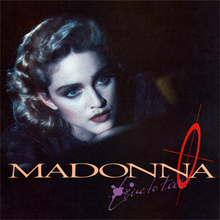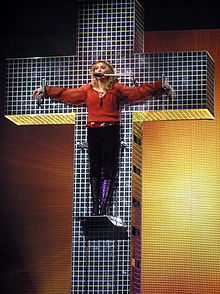
Who's That Girl is the first soundtrack album by American singer and songwriter Madonna. It was released on July 21, 1987, by Sire Records to promote the film of the same name. It also contains songs by her label mates Scritti Politti, Duncan Faure, Club Nouveau, Coati Mundi and Michael Davidson. The soundtrack is credited as a Madonna album, despite her only performing four of the nine tracks on the album. After the commercial success of the film Desperately Seeking Susan (1985), in which she co-starred, Madonna wanted to act in another comedy film titled Slammer, about a woman named Nikki Finn who was falsely accused of homicide. However, due to the critical and commercial failure of her adventure film Shanghai Surprise (1986), Warner Bros. was initially reluctant to greenlight the project but later agreed.

"Who's That Girl" is a song by American singer Madonna from the soundtrack of the 1987 film of the same name. Written and produced by Madonna and Patrick Leonard, it was released in Europe as the soundtrack's lead single on June 29, 1987; in the United States, a release was issued the following day. An uptempo pop song, "Who's That Girl" continued the singer's fascination with Latin pop, a genre she had previously explored on her single "La Isla Bonita". It features instrumentation from drums, bass, and trumpets, and has lyrics sung both in English and Spanish. While shooting for the film, then called Slammer, Madonna had requested Leonard to develop a song that captured the nature of her character; the producer worked on a demo and, afterwards, Madonna added the lyrics and decided to rename the song, as well as the film, to "Who's That Girl".

"Papa Don't Preach" is a song by the American singer-songwriter Madonna, released on her third studio album True Blue (1986). It was written by Brian Elliot with additional lyrics by Madonna, and produced by Madonna and Stephen Bray. "Papa Don't Preach" combines pop and classical styles, with lyrics about teenage pregnancy, and the choices that come with it. Elliot was inspired by the teen gossip he heard outside his recording studio.

True Blue is the third studio album by American singer-songwriter Madonna, released on June 30, 1986, by Sire Records. In early 1985, Madonna became romantically involved with actor Sean Penn, and married him six months later on her 27th birthday. Additionally, she met producer Patrick Leonard while on the Virgin Tour, and formed a professional relationship with him. The first songs they created together were "Love Makes the World Go Round", and the ballad "Live to Tell", which was featured on At Close Range, a film which Penn starred. On late 1985, Madonna and Leonard began working on her third studio album; she also enlisted the help of former boyfriend Stephen Bray, with whom she had worked on her previous record Like a Virgin (1984). Titled True Blue, the record saw Madonna co-writing and co-producing for the first time in her career. Inspired by Madonna's love for Penn, to whom she dedicated it, True Blue is a dance-pop album that features influences of Motown sound, girl groups, and Latin pop.
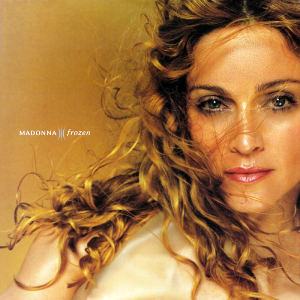
"Frozen" is a song by American singer and songwriter Madonna from her seventh studio album, Ray of Light (1998). Maverick and Warner Bros. Records released it as the album's lead single on January 23, 1998. The song was also included on the compilation albums, GHV2 (2001) and Celebration (2009). "Frozen" was written by Madonna and Patrick Leonard, who both produced it in collaboration with William Orbit. The downtempo electronica ballad, which has a layered sound enhanced by synthesizers and strings, lyrically addresses a cold and emotionless man.

"Dress You Up" is a song by American singer Madonna from her second studio album, Like a Virgin (1984). It was released as the album's final single on July 24, 1985, by Sire Records. Written by Andrea LaRusso and Peggy Stanziale, and produced by Nile Rodgers, who also played guitar on the track, it was the final song to be added to the album. Rodgers had asked the writers to compose something similar to the work of his band Chic but, due to LaRusso and Stanziale being busy with other projects, the composition took time. When the lyrics were submitted, the producer initially rejected them, as he felt there was no time to compose a melody; Madonna, however, liked the lyrics and convinced him to include the song on Like a Virgin. Musically, "Dress You Up" is a dance-pop song whose lyrics are an extended metaphor for fashion and lust, comparing dressing up with passion.

"Music" is a song recorded by American singer Madonna as the title track for her eighth studio album of the same name (2000). It was released as the lead single from the album to radio on August 1, 2000, by Maverick and Warner Bros. Records and commercially released on August 21. "Music" was inspired by a Sting concert Madonna attended and was written and produced by her with Mirwais Ahmadzaï. It is a electropop, disco, electro-funk and dance-pop song in a static key of G minor. Madonna's vocals are electronically manipulated in the track, with the lyrics having political and social undertones and reiterating the uniting power of music.
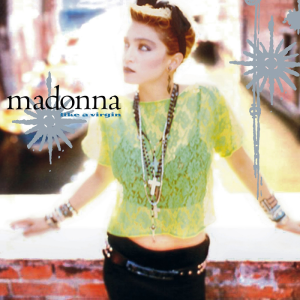
"Like a Virgin" is a song recorded by American singer Madonna from her second album of the same name. The song was written and composed by Tom Kelly and Billy Steinberg, and it was released as the album's lead single on October 31, 1984. A dance song with two hooks, Madonna sings in a high register while a continuous arrangement of synths are heard along the bassline. The song's lyrics are ambiguous, consisting of hidden innuendos and open to various interpretations.

"Causing a Commotion" is a song by American singer Madonna from the soundtrack album to the 1987 film Who's That Girl. It was released as the album's second single on August 25, 1987, by Sire Records. Its Silver Screen Single Mix later appeared on the EP The Holiday Collection (1991). Written and produced by Madonna and Stephen Bray, the song was inspired by her relationship with then-husband Sean Penn, and his abusive and violent nature. Containing a dance-oriented, up-tempo groove, the song begins with the chorus and is accompanied by a four-note descending bassline and staccato chords in the verses.

"Crazy for You" is a song recorded by American singer Madonna for the film Vision Quest (1985). It was released on March 2, 1985 by Geffen Records as the lead single from the film's soundtrack album. Film producers Jon Peters and Peter Guber, along with music director Phil Ramone, decided to use Madonna after listening to her previous recordings, employing John Bettis and Jon Lind to write the song. After reading the script of the film, Bettis and Lind wrote the song about the situation in which the lead characters meet at a nightclub. Initial recording sessions did not impress Bettis and Lind, and they felt that "Crazy for You" would be dropped from the soundtrack. However, a new version was recorded to their liking.

"Into the Groove" is a song recorded by American singer Madonna, and featured on the 1985 film Desperately Seeking Susan. Written and produced by both Madonna and Stephen Bray, the main inspiration behind the song was the dance floor; the singer wrote it while watching a Latin American man to whom she was attracted. Its instrumentation features synthesizers and drum machines, with Madonna's voice being double tracked on the chorus. Sexual innuendos and undertones are present throughout the lyrics, which are written as an invitation to dance with the singer. Originally written for her friend Mark Kamins, Madonna later decided to use it on the film, as one of the scenes needed a dance song. It was later added to the 1985 international re-issue of her second studio album, Like a Virgin (1984), and remixed for her compilations You Can Dance (1987), The Immaculate Collection (1990), and Finally Enough Love: 50 Number Ones (2022).

Something to Remember is a compilation album by American singer Madonna, released by Maverick Records on November 3, 1995. The album was conceived after a highly controversial period in Madonna's career, during which many critics speculated that her career was in decline. The compilation of ballads presented a softer image for the singer and span over a decade, including a reworked version of "Love Don't Live Here Anymore" as well as three new songs: "You'll See", "One More Chance" and a cover of Marvin Gaye's "I Want You". The singles "I'll Remember" and "This Used to Be My Playground", were also included, marking the first time these songs were featured on a Madonna album.

"Open Your Heart" is a song recorded by American singer-songwriter Madonna for her third studio album True Blue (1986). Written by Gardner Cole and Peter Rafelson, it was conceived as a rock and roll song titled "Follow Your Heart" for singer Cyndi Lauper, but Cole and Rafaelson never had the chance to play it for her. At the time, Cole's management was working with Madonna's, who were looking for material for her third studio album. After her manager asked Cole to present a female demo of the song, Madonna accepted it and, alongside producer Patrick Leonard, turned it into a dance song. Lyrically, it's an innuendo-laden love song where the singer expresses her sexual desire. In the United States, the song was released as the fourth single from True Blue on November 12, 1986; overseas, it was released on December 1. Furthermore, it was included in the compilation albums, The Immaculate Collection (1990), Celebration (2009), and the "video version" was featured on the 2023 remix-themed compilation, Finally Enough Love: 50 Number Ones.

"La Isla Bonita" is a song by American singer Madonna from her third studio album True Blue (1986). Patrick Leonard and Bruce Gaitsch created it as an instrumental demo and offered it to singer Michael Jackson, who turned it down. When Leonard met Madonna to start working on True Blue, he played the demo for her. Madonna came up with the title, wrote the lyrics and produced the song with Leonard. It is her first song with Latin influences. Its instrumentation features flamenco guitar, Latin percussion, maracas, and includes four lines sung in Spanish. The lyrics talk about an island named San Pedro, whose location has been debated. Madonna said the song was her tribute to Latin Americans.

"Like a Prayer" is a song by American singer Madonna from her 1989 fourth studio album of the same name. It was released as the album's lead single on March 3, 1989, by Sire Records. Written and produced by both Madonna and Patrick Leonard, the song heralded an artistic and personal approach to songwriting for Madonna, who believed that she needed to cater more to her adult audience. Thematically, the song speaks about a passionate young girl in love with God, who becomes the only male figure in her life.

"Take a Bow" is a song by American singer Madonna from her sixth studio album, Bedtime Stories (1994). It was released as the album's second single on December 6, 1994, by Maverick Records. It is a midtempo pop ballad written and produced by Madonna and Babyface. Following the sexually explicit persona portrayed by Madonna on her previous album, Erotica, she wanted to tone down her image for Bedtime Stories. Experimenting with a new musical direction and a more radio-friendly sound, Madonna decided to collaborate with Babyface, whose work with other musicians had impressed her. "Take a Bow" was developed after she listened to the basic beat and chords of a piece of music composed by him.

"Rain" is a song by American singer Madonna from her fifth studio album, Erotica (1992), released by Maverick, Sire and Warner. Written and produced by Madonna and Shep Pettibone, in Australia and most European countries, the song was released as the album's fifth single on July 17, 1993; in the United States, a release was issued on August 5. A pop ballad that mixes elements of R&B, trip-hop, and new-age music, its lyrics liken water and rainfall to the power of love.
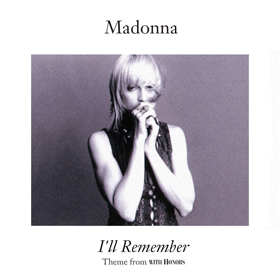
"I'll Remember" is a song by American singer Madonna for the 1994 film With Honors. It was released by Maverick and Warner Bros. Records on March 8, 1994, as the lead single from the film's soundtrack album. It was a radical change in image and style for Madonna, who had received huge backlash due to the release of her book Sex, the studio album Erotica and the film Body of Evidence. Warner Bros. decided to release the song for the film after noting most of her previous soundtrack singles had achieved commercial success. It utilizes a synthesized keyboard arrangement to bring about a continuously reverberating heartbeat sound. Madonna's voice is supported by backing vocals.

"This Used to Be My Playground" is a song recorded by American singer Madonna. It is the theme for the film A League of Their Own, which starred Madonna, and portrayed a fictionalized account of the real-life All-American Girls Professional Baseball League. Madonna was asked to record a song for the film's soundtrack. At that time she was busy recording her fifth studio album, Erotica, with producer Shep Pettibone. They worked on some ideas and came up with "This Used to Be My Playground" in two days. Once presented to director Penny Marshall's team, the song was released as a standalone single on June 16, 1992, by Warner Bros. Records. However, it was not available on the film's soundtrack due to contractual obligations and was later added to the Olympics-inspired Barcelona Gold compilation album, released that summer. The song was included on Madonna's 1995 ballads compilation Something to Remember.

"Get Together" is a song by American singer Madonna from her tenth studio album, Confessions on a Dance Floor (2005). The song was written and produced by both Madonna and Stuart Price, with additional writing by Anders Bagge and Peer Åström. It was released in the United States as the third single from the album on May 30, 2006, by Warner Bros. Records. The decision was spurred by the fact that the song was the third most downloaded song from the album, following its previous singles. The song was also released to coincide with the start of Madonna's Confessions Tour. It is a disco-influenced electropop, trance and techno song which lyrically talks about the possibility of finding love on the dancefloor.
